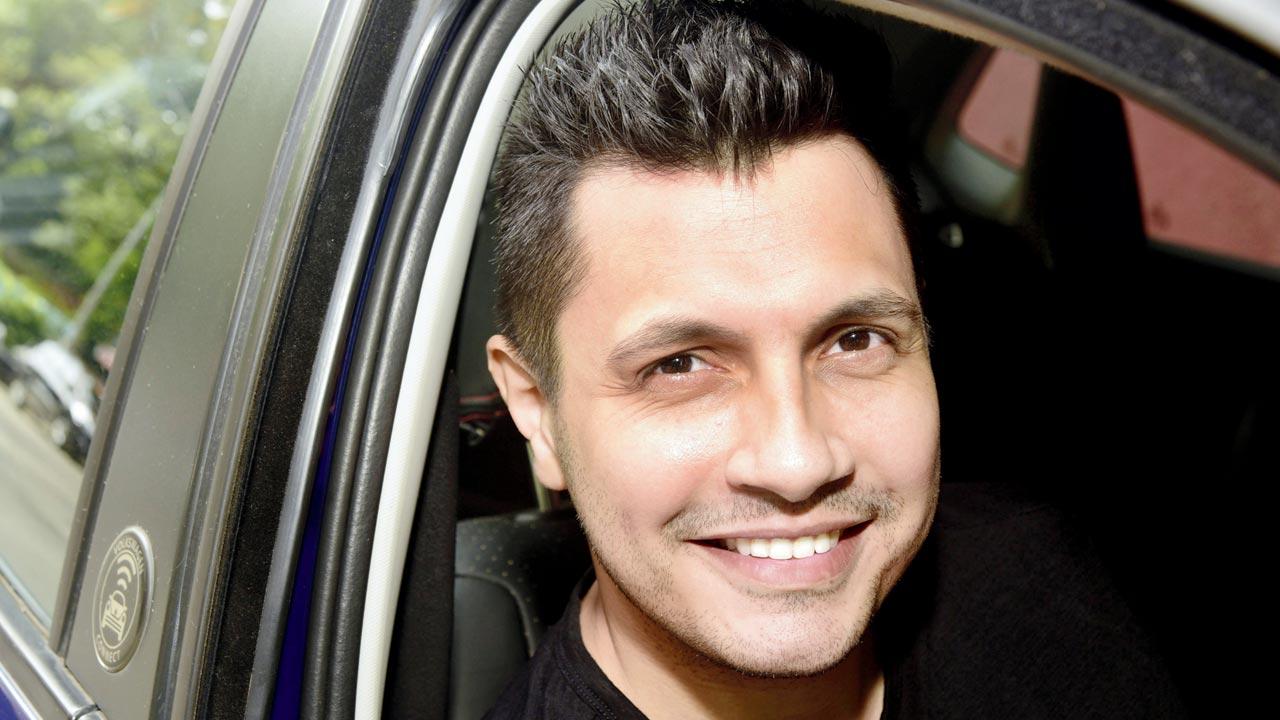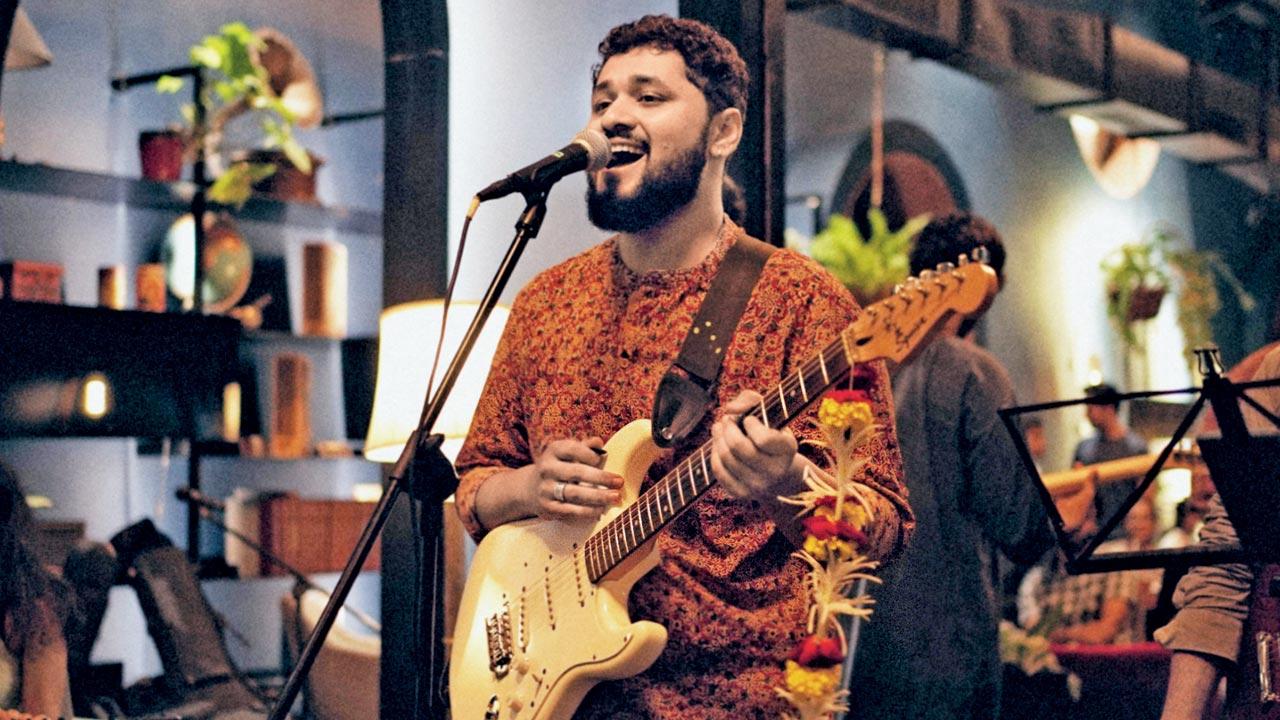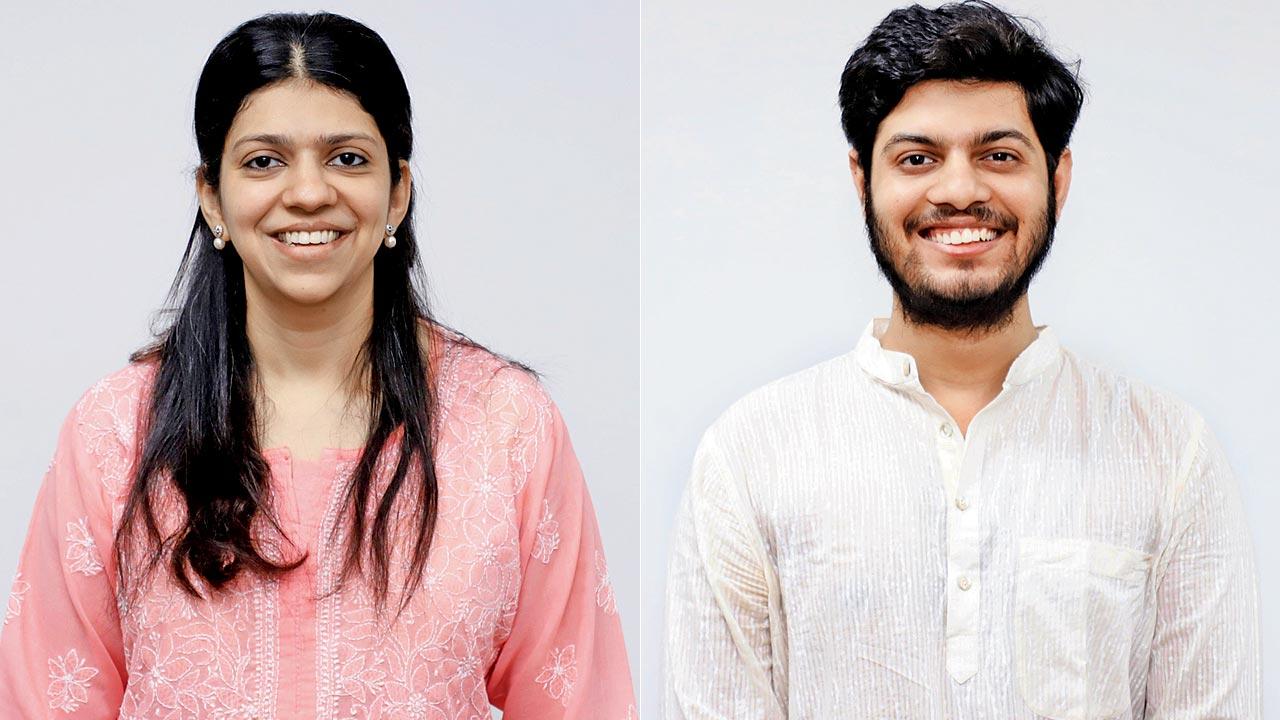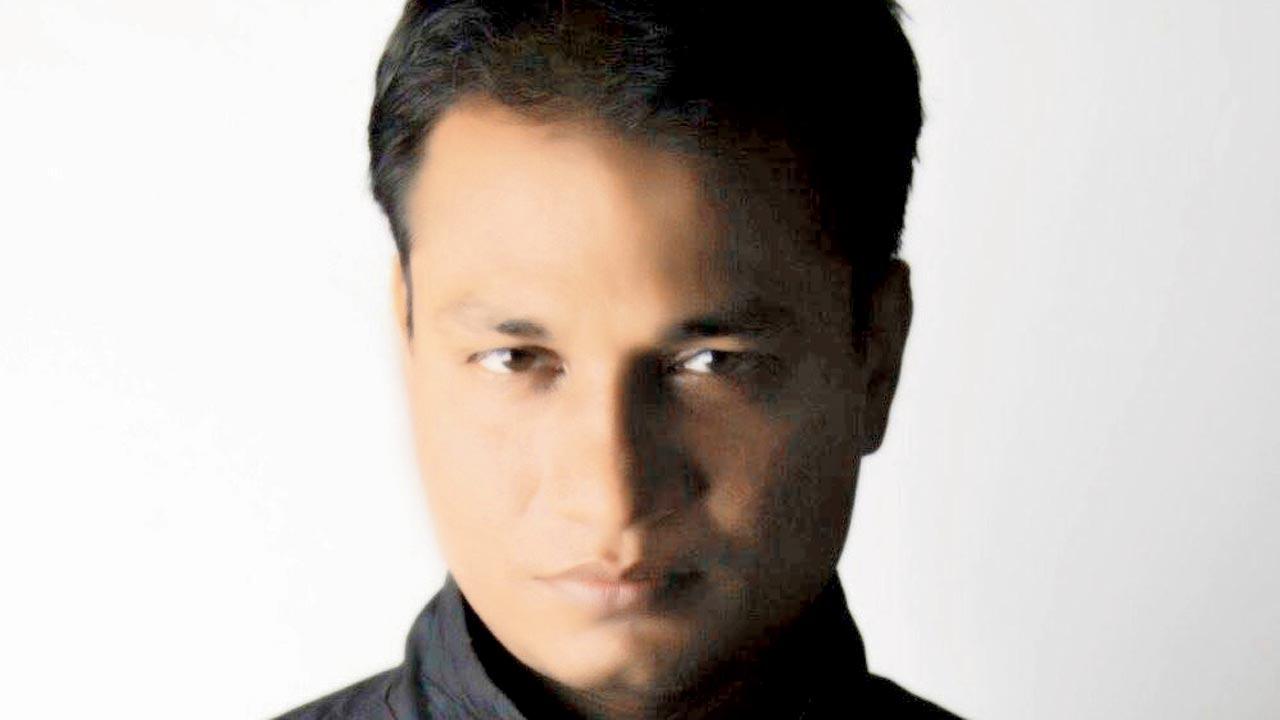A first-of-its-kind survey of India’s informal music industry, worth nearly R5,620 billion, reveals that cutthroat competition, financial insecurity, and piracy is making players more vulnerable

Akash Chopra, who has been a full-time musician and music educator for eight years says that every independent artiste needs multiple sources of income to sustain. Pic/Shadab Khan
At 28, multi-hyphenate artiste Akash Chopra is still struggling to find his footing in the Hindi film music industry. The singer, songwriter and composer, has been in Mumbai for the last seven months, assisting a leading musical duo. Prior to that, the certified guitar teacher from the Trinity School of Music in London, worked as musical educator in his hometown Jaipur. The average salary for a music teacher there is around Rs 20,000 a month. “As a fresher, you are paid far less... around Rs 10,000,” says Chopra, who decided to move cities, after facing a severe financial crunch during the 2020 pandemic.
One would imagine that the shift to Mumbai, and working in Bollywood, would have brought a change in fortune. “No, unfortunately,” says Chopra, when we meet him at his rented apartment in Versova, where he shares a room with a friend. “It doesn’t matter which city you are in, if you are an independent musician, you will never earn enough... As an artiste, you have to dabble in multiple things to bring food to the table.”
 Samuel Berlie
Samuel Berlie
Chopra’s sentiments were echoed in a just released first-of-its-kind study by economic policy think tank Indian Council for Research on International Economic Relations (ICRIER). This covered the informal music industry, which includes DJs and their helpers, brass band members, sound engineers, independent artistes, musicians, teachers and small-scale manufacturers. According to the report, the average salary of the informal music industry that employs almost 14 million people “is lower than the median salary of an unskilled worker under the Minimum Wage Act, 1948”, which is less than Rs 29,000. This, despite the informal industry’s worth being anywhere between Rs 1,398 and Rs 5,620 billion, when compared to the ‘formal’ music industry (recording studios and digital streaming), which according to EY-FICCI estimates, is valued at about Rs 18.7 billion. “It was the Indian Music Industry (IMI) [apex body which represents the interests of the recorded music industry in India] that approached us to understand the potential of this sector... it has never been covered or researched before, perhaps because it was assumed to be very complex, with too many types of professionals, practices and sub-sectors and also, because of the part-time nature of it,” co-author Mansi Kedia tells mid-day.
Fellow author Mayank Manish says that “such assumptions also rendered the sector invisible” and unprotected under law. The impact of it, he says, was felt most during the COVID-19 pandemic, which imposed a disproportionate burden on the sector.

Nishad Padhye, a singer-songwriter based out of Vadodara earns anywhere between Rs 7,000 and Rs 9,000 a month
DJ Emaan entered the music scene in 1998. For nearly two decades, he says, he chose to work under a senior DJ, contracted by hotels, restaurants and clubs in Mumbai. “While they may have signed up hefty contracts, those working with them would earn a pittance...” he says. Until 2016, Emaan would make Rs 30,000 monthly, this despite having nearly 18 years of experience as a DJ. “High-profile contractors have complete monopoly over this industry, and this leads to exploitation. I had to depend on private gigs to earn extra money.” It’s why he decided to branch out, and work independently, taking up short-term residency opportunities and high-profile gigs, across the country. The financial stability that came with being his own lord and master was cut short when the pandemic hit. “I was in Chennai but was forced to return to Mumbai. For the next year and more, there were absolutely no shows. I had zero income. To be honest, I was in a financial mess. Until then, I had not even considered diversifying.”
Even after the lockdown was lifted, opportunities in Mumbai were few and far between. Over the last few years, the electronic music scene has exploded and how. “There was a time when there were 25 DJs in the country, today there are 25 in one locality [of a suburb]. This influx is quite detrimental to us... the freshers are willing to play for measly sums, sometimes even pro bono. This has affected our bargaining power,” he says. “Nobody wants to pay for quality.” Singer and performing artist Samuel Berlie agrees: “Many musicians take whatever they get, without negotiating for their skill-set. Then there are the youngsters, who play just for the exposure... what they don’t realise is that they’re killing the industry.”
 Santosh Ramakant Chopdekar, an accountant by profession, and a veteran sound engineer, says there’s a lot of uncertainty in his field, especially with payments never coming in on time. “In 2020, I had been asked to provide my sound system for a major carnival in Powai. I was to be paid Rs1.5 lakh for 15 days of work. It’s been two years, and I am yet to get Rs 83,000”
Santosh Ramakant Chopdekar, an accountant by profession, and a veteran sound engineer, says there’s a lot of uncertainty in his field, especially with payments never coming in on time. “In 2020, I had been asked to provide my sound system for a major carnival in Powai. I was to be paid Rs1.5 lakh for 15 days of work. It’s been two years, and I am yet to get Rs 83,000”
The ICRIER study points to a major reason for the music industry lagging: the long-standing challenges of underpayment by consumers of music. Other reasons include rampant sale and consumption of pirated content, massive digitisation and an ad-supported streaming user base. Ironically, India does not feature among the top 10 music markets in the world despite being one of the largest in South Asia.
Vadodara-based singer Nishad Padhye, says gigs in his city are rare as most people here are not interested in originals. “The city has a DIY-centric scene, which means that independent musicians have to look after their own show, right from renting the venue to performing,” says the 22-year-old. “We work on a no-profit, no-loss basis and sometimes, we tend to spend more, and even run into debt.” He earns anywhere between Rs 7,000 and Rs 9,000 a month; during the wedding season it doubles. During his cub years, he earned as low as Rs 800 per show. “Since I work in dry state, fewer pubs bother with shows as they don’t get revenue out of bar sales. All of this affects us, as musicians.”
 Mansi Kedia and Mayank Manish, co-authors of the just-released ICRIER survey, The Untold Potential of India’s Informal Music Industry, say that the sector urgently requires policy attention
Mansi Kedia and Mayank Manish, co-authors of the just-released ICRIER survey, The Untold Potential of India’s Informal Music Industry, say that the sector urgently requires policy attention
Santosh Ramakant Chopdekar, an accountant by profession, is a veteran sound engineer. Trained under his father, he has been in the business for the last 30 years. Yet, he won’t recommend it as a full-time job.
In the ICRIER survey, 43 per cent of the sound engineers interviewed earned less than Rs 50,000 per month and 48 per cent earned less than Rs 25,000 per month. “The average monthly income for sound engineers ranges from Rs 16,000 to Rs 41,000... Less than 5 per cent of the respondents paid income tax.”
 DJ Emaan, who is currently working as consultant for a hotel chain in Goa, says that with freshers charging a measly sum, or sometimes even working pro bono, the bargaining power of the industry has dropped
DJ Emaan, who is currently working as consultant for a hotel chain in Goa, says that with freshers charging a measly sum, or sometimes even working pro bono, the bargaining power of the industry has dropped
Chopdekar says that there’s a lot of uncertainty in his field, “And you need to constantly invest in good quality equipment, for which you need money coming in. Just before the pandemic, I had been asked to provide my sound system for a major carnival in Powai. I was to be paid Rs 1.5 lakh for 15 days of work. It’s been two years, and I am yet to get Rs 83,000.”
The Indian Performing Rights Society Ltd (IPRS) and the Phonographic Performance Limited (PPL) are the leading organisations that govern the commercial use of music in India. Yet, when royalty collections and registered members of music associations are compared with other countries, India’s collections in 2020-21 were the lowest, the study indicates. The authors of the survey interviewed the stakeholders, and Manish says that they learnt that during the pandemic, it was these royalties, which actually brought some income to the artistes. “Even if it was abysmal and as low as Rs 5,000 or Rs 10,000,” he says.
Speaking with mid-day, Rakesh Nigam, CEO, IPRS says, “As a Copyright Society, we urge all creators, who are our members, to submit their work details error-free and complete in all respect. The importance of metadata cannot be ignored in today’s digital world. Claiming, matching, and distribution of royalties for the usage of the songs are directly linked to the metadata in our database. An error in the data will lead to a loss of revenue by an artist/creator.”
While the authors admit that the survey hasn’t been able to capture the entire gamut of the informal music industry—folk artistes and Maharashtra’s dhol tasha players, for instance—they hope that it will help the sector find mainstream attention. “There are so many people whose livelihoods depend on this industry, but there’s no policy discussion yet,” says Manish. Some of their recommendations include improving and increasing public infrastructure for live performances, strengthening the role of institutions and associations, improving quality by training and professionalisation of artistes and sound engineers, and stronger enforcement of Intellectual property rights laws. “We all engage with these people so frequently, but never realised that there’s a massive economy that underlies all of this, and what it would mean. We do plan to have a few stakeholder meetings, and take our report to industry representatives and government bodies. From those discussions we hope that a more well-rounded research emerges which explores the untapped potential of this sector,” says Kedia.
14 million
Average size of India’s indie music industry whose members earn less than the median salary of unskilled workers
 Subscribe today by clicking the link and stay updated with the latest news!" Click here!
Subscribe today by clicking the link and stay updated with the latest news!" Click here!










